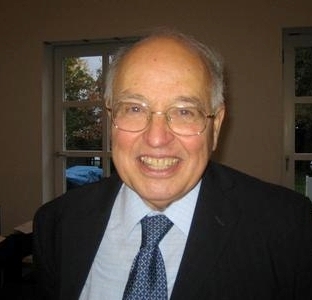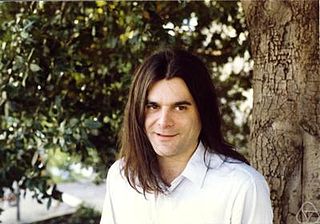Related Research Articles

Sir Michael Francis Atiyah was a British-Lebanese mathematician specialising in geometry. His contributions include the Atiyah–Singer index theorem and co-founding topological K-theory. He was awarded the Fields Medal in 1966 and the Abel Prize in 2004.
In mathematics, Fredholm operators are certain operators that arise in the Fredholm theory of integral equations. They are named in honour of Erik Ivar Fredholm. By definition, a Fredholm operator is a bounded linear operator T : X → Y between two Banach spaces with finite-dimensional kernel and finite-dimensional (algebraic) cokernel , and with closed range . The last condition is actually redundant.

In mathematics, an involution, involutory function, or self-inverse function is a function f that is its own inverse,
In differential geometry, the Atiyah–Singer index theorem, proved by Michael Atiyah and Isadore Singer (1963), states that for an elliptic differential operator on a compact manifold, the analytical index is equal to the topological index. It includes many other theorems, such as the Chern–Gauss–Bonnet theorem and Riemann–Roch theorem, as special cases, and has applications to theoretical physics.
Vladimir Gershonovich Drinfeld, surname also romanized as Drinfel'd, is a renowned mathematician from the former USSR, who emigrated to the United States and is currently working at the University of Chicago.
In mathematics, K-homology is a homology theory on the category of locally compact Hausdorff spaces. It classifies the elliptic pseudo-differential operators acting on the vector bundles over a space. In terms of -algebras, it classifies the Fredholm modules over an algebra.
In mathematics, in particular in partial differential equations and differential geometry, an elliptic complex generalizes the notion of an elliptic operator to sequences. Elliptic complexes isolate those features common to the de Rham complex and the Dolbeault complex which are essential for performing Hodge theory. They also arise in connection with the Atiyah-Singer index theorem and Atiyah-Bott fixed point theorem.
In mathematics, a D-module is a module over a ring D of differential operators. The major interest of such D-modules is as an approach to the theory of linear partial differential equations. Since around 1970, D-module theory has been built up, mainly as a response to the ideas of Mikio Sato on algebraic analysis, and expanding on the work of Sato and Joseph Bernstein on the Bernstein–Sato polynomial.
In mathematics, the Atiyah–Bott fixed-point theorem, proven by Michael Atiyah and Raoul Bott in the 1960s, is a general form of the Lefschetz fixed-point theorem for smooth manifolds M, which uses an elliptic complex on M. This is a system of elliptic differential operators on vector bundles, generalizing the de Rham complex constructed from smooth differential forms which appears in the original Lefschetz fixed-point theorem.
In mathematics, twisted K-theory is a variation on K-theory, a mathematical theory from the 1950s that spans algebraic topology, abstract algebra and operator theory.
In mathematics, Fredholm theory is a theory of integral equations. In the narrowest sense, Fredholm theory concerns itself with the solution of the Fredholm integral equation. In a broader sense, the abstract structure of Fredholm's theory is given in terms of the spectral theory of Fredholm operators and Fredholm kernels on Hilbert space. The theory is named in honour of Erik Ivar Fredholm.

Graeme Bryce Segal FRS is an Australian mathematician, and professor at the University of Oxford.
In mathematics, elliptic cohomology is a cohomology theory in the sense of algebraic topology. It is related to elliptic curves and modular forms.
In mathematics, Harish-Chandra's regularity theorem, introduced by Harish-Chandra (1963), states that every invariant eigendistribution on a semisimple Lie group, and in particular every character of an irreducible unitary representation on a Hilbert space, is given by a locally integrable function. Harish-Chandra proved a similar theorem for semisimple p-adic groups.
In mathematics, KK-theory is a common generalization both of K-homology and K-theory as an additive bivariant functor on separable C*-algebras. This notion was introduced by the Russian mathematician Gennadi Kasparov in 1980.
In mathematics, operator K-theory is a noncommutative analogue of topological K-theory for Banach algebras with most applications used for C*-algebras.
In operator theory, a Toeplitz operator is the compression of a multiplication operator on the circle to the Hardy space.
In noncommutative geometry and related branches of mathematics and mathematical physics, a spectral triple is a set of data which encodes a geometric phenomenon in an analytic way. The definition typically involves a Hilbert space, an algebra of operators on it and an unbounded self-adjoint operator, endowed with supplemental structures. It was conceived by Alain Connes who was motivated by the Atiyah-Singer index theorem and sought its extension to 'noncommutative' spaces. Some authors refer to this notion as unbounded K-cycles or as unbounded Fredholm modules.
In mathematics, and especially differential geometry, the Quillen metric is a metric on the determinant line bundle of a family of operators. It was introduced by Daniel Quillen for certain elliptic operators over a Riemann surface, and generalized to higher-dimensional manifolds by Jean-Michel Bismut and Dan Freed.
This is a glossary for the terminology in a mathematical field of functional analysis.
References
The paper by Atiyah is reprinted in volume 3 of his collected works, (Atiyah 1988a , 1988b )
- Connes, Alain (1994), Non-commutative geometry , Boston, MA: Academic Press, ISBN 978-0-12-185860-5
- Atiyah, M. F. (1970), "Global Theory of Elliptic Operators", Proc. Int. Conf. on Functional Analysis and Related Topics (Tokyo, 1969), University of Tokio, Zbl 0193.43601
- Atiyah, Michael (1988a), Collected works. Vol. 3. Index theory: 1, Oxford Science Publications, New York: The Clarendon Press, Oxford University Press, ISBN 0-19-853277-6, MR 0951894